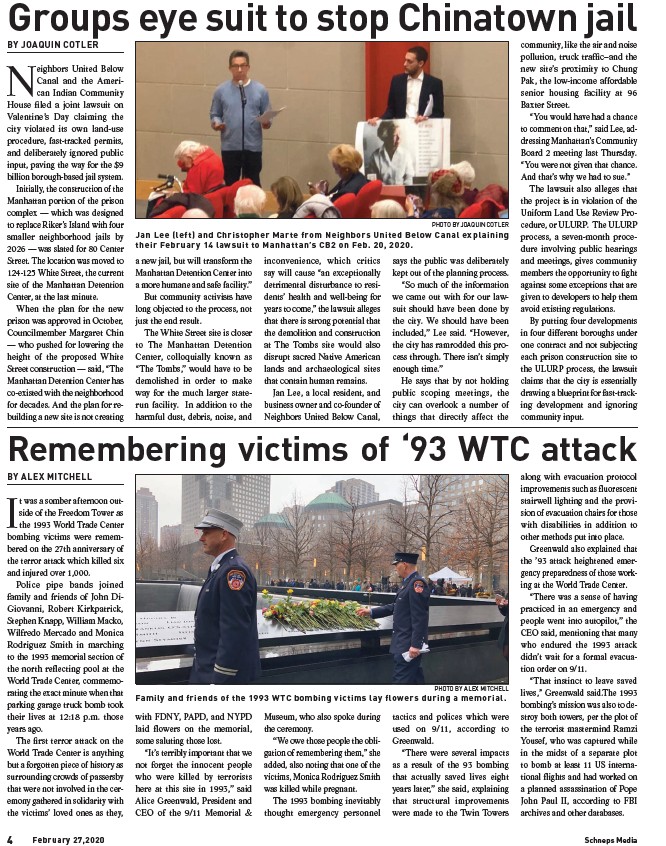
Groups eye suit to stop Chinatown jail
BY JOAQUIN COTLER
Neighbors United Below
Canal and the American
Indian Community
House filed a joint lawsuit on
Valentine’s Day claiming the
city violated its own land-use
procedure, fast-tracked permits,
and deliberately ignored public
input, paving the way for the $9
billion borough-based jail system.
Initially, the construction of the
Manhattan portion of the prison
complex — which was designed
to replace Riker’s Island with four
smaller neighborhood jails by
2026 — was slated for 80 Center
Street. The location was moved to
124-125 White Street, the current
site of the Manhattan Detention
Center, at the last minute.
When the plan for the new
prison was approved in October,
Councilmember Margaret Chin
— who pushed for lowering the
height of the proposed White
Street construction — said, “The
Manhattan Detention Center has
co-existed with the neighborhood
for decades. And the plan for rebuilding
a new site is not creating
Jan Lee (left) and Christopher Marte from Neighbors United Below Canal explaining
their February 14 lawsuit to Manhattan’s CB2 on Feb. 20, 2020.
a new jail, but will transform the
Manhattan Detention Center into
a more humane and safe facility.”
But community activists have
long objected to the process, not
just the end result.
The White Street site is closer
to The Manhattan Detention
Center, colloquially known as
“The Tombs,” would have to be
demolished in order to make
way for the much larger staterun
facility. In addition to the
harmful dust, debris, noise, and
inconvenience, which critics
say will cause “an exceptionally
detrimental disturbance to residents’
health and well-being for
years to come,” the lawsuit alleges
that there is strong potential that
the demolition and construction
at The Tombs site would also
disrupt sacred Native American
lands and archaeological sites
that contain human remains.
Jan Lee, a local resident, and
business owner and co-founder of
Neighbors United Below Canal,
PHOTO BY JOAQUIN COTLER
says the public was deliberately
kept out of the planning process.
“So much of the information
we came out with for our lawsuit
should have been done by
the city. We should have been
included,” Lee said. “However,
the city has ramrodded this process
through. There isn’t simply
enough time.”
He says that by not holding
public scoping meetings, the
city can overlook a number of
things that directly affect the
community, like the air and noise
pollution, truck traffic–and the
new site’s proximity to Chung
Pak, the low-income affordable
senior housing facility at 96
Baxter Street.
“You would have had a chance
to comment on that,” said Lee, addressing
Manhattan’s Community
Board 2 meeting last Thursday.
“You were not given that chance.
And that’s why we had to sue.”
The lawsuit also alleges that
the project is in violation of the
Uniform Land Use Review Procedure,
or ULURP. The ULURP
process, a seven-month procedure
involving public hearings
and meetings, gives community
members the opportunity to fight
against some exceptions that are
given to developers to help them
avoid existing regulations.
By putting four developments
in four different boroughs under
one contract and not subjecting
each prison construction site to
the ULURP process, the lawsuit
claims that the city is essentially
drawing a blueprint for fast-tracking
development and ignoring
community input.
Remembering victims of ‘93 WTC attack
BY ALEX MITCHELL
It was a somber afternoon outside
of the Freedom Tower as
the 1993 World Trade Center
bombing victims were remembered
on the 27th anniversary of
the terror attack which killed six
and injured over 1,000.
Police pipe bands joined
family and friends of John Di-
Giovanni, Robert Kirkpatrick,
Stephen Knapp, William Macko,
Wilfredo Mercado and Monica
Rodriguez Smith in marching
to the 1993 memorial section of
the north reflecting pool at the
World Trade Center, commemorating
the exact minute when that
parking garage truck bomb took
their lives at 12:18 p.m. those
years ago.
The first terror attack on the
World Trade Center is anything
but a forgotten piece of history as
surrounding crowds of passersby
that were not involved in the ceremony
gathered in solidarity with
the victims’ loved ones as they,
Family and friends of the 1993 WTC bombing victims lay flowers during a memorial.
with FDNY, PAPD, and NYPD
laid flowers on the memorial,
some saluting those lost.
“It’s terribly important that we
not forget the innocent people
who were killed by terrorists
here at this site in 1993,” said
Alice Greenwald, President and
CEO of the 9/11 Memorial &
Museum, who also spoke during
the ceremony.
“We owe those people the obligation
of remembering them,” she
added, also noting that one of the
victims, Monica Rodriguez Smith
was killed while pregnant.
The 1993 bombing inevitably
thought emergency personnel
PHOTO BY ALEX MITCHELL
tactics and polices which were
used on 9/11, according to
Greenwald.
“There were several impacts
as a result of the 93 bombing
that actually saved lives eight
years later,” she said, explaining
that structural improvements
were made to the Twin Towers
along with evacuation protocol
improvements such as fluorescent
stairwell lighting and the provision
of evacuation chairs for those
with disabilities in addition to
other methods put into place.
Greenwald also explained that
the ’93 attack heightened emergency
preparedness of those working
at the World Trade Center.
“There was a sense of having
practiced in an emergency and
people went into autopilot,” the
CEO said, mentioning that many
who endured the 1993 attack
didn’t wait for a formal evacuation
order on 9/11.
“That instinct to leave saved
lives,” Greenwald said.The 1993
bombing’s mission was also to destroy
both towers, per the plot of
the terrorist mastermind Ramzi
Yousef, who was captured while
in the midst of a separate plot
to bomb at least 11 US international
flights and had worked on
a planned assassination of Pope
John Paul II, according to FBI
archives and other databases.
4 February 27,2020 Schneps Media